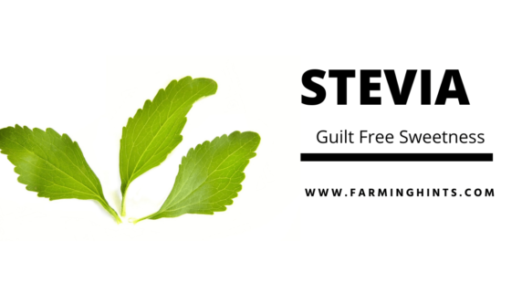Stevia production is famous in the world because of its sweet leaves and zero-caloric nature. It has been found naturally in Paraguay as well as in Brazil. However, now its cultivation has been started at the world level. Its sweetness nearly tastes like table sugar. The leaves sweetness is about 10 to 15 times more than that of normal sugar and Its stevioside is 200-300 times sweeter than sugar. Recovery of stevioside from stevia leaves is about 10 percent while 2-3 percent from stems and branches.
Stevia is a small perennial shrub-like plant that can be grown for up to five years with care once planted. It can grow to one-meter length annually. Its leaves’ length ranges from 2 cm to 10 cm. It has been reported by researchers that the average production of stevia was found to be 30 mounds of dry leaves in subtropical regions of Asia.
Stevia leaves are 10 to 15 times sweeter than sugarcane and its extract stevioside is 200-300 times sweeter than cane sugar.
Nutritional Composition of Stevia
It has been observed through analysis, that Stevia leaves are full of nutrition. If 100 grams of dry stevia leaves are analyzed, they will contain 7-gram water content, 10-gram protein, 52-gram starch, 14.98-milligram vitamin C, 58.18-milligram Folic Acid, 0.00-milligram niacin, and 0.00-milligram thiamin.
Moreover, other elements like calcium 464.4 milligrams, phosphorus 11.4 mg, iron 53.3 milligrams, sodium 190.0 milligrams, and potassium 180.0 milligrams are also found in stevia leaves.
Important Medicinal Benefits of Stevia:
-
-
- Because of zero calories, it is ideal for diabetic patients.
- It regulates blood sugar levels.
- It regulates blood pressure levels.
- It has antimicrobial properties due to which it has multiple industrial uses.
- Stevia plants protect our teeth and gums because it has a natural sweetness. That’s why it is used in many kinds of toothpaste.
- It has relatively higher contents of calcium and other minerals.
- Research has found its use in treating metabolic disorders.
- Stevioside (a white crystal compound found in 1931 for the first time) is reported to enhance skeletal muscle glucose transportation as the action of insulin on glucose transport might be improved due to the low concentration of stevioside.
- Stevia is well known for its therapeutic properties like anti-tumor, anti-bacterial, anti-inflammatory, anti-diarrheal, diuretic, anti-human rota-virus activities, anti-viral, antifungal, anti-hypertensive, anti-hyperglycaemic, anti-HIV, and immune-modulatory effects
- Stevia has been found safe for the consumption of every person because it does not have any adverse effect on the human body as studies confirm that it is non-teratogenic, non-mutagenic/non-carcinogenic.
- Stevia extract may stimulate beta cells of the pancreas to secrete insulin. Beta cells are the specific cells in the human pancreas that are meant for insulin production.
-
Financial Importance
Stevia can be harvested twice a year. Due to its higher production rate i.e. 40 -45 mounds per acre, it is more profitable than other conventional crops like wheat, rice, cotton, etc.
stevia per acre profit is several times higher than other conventional crops. About 2000- 2500 kg of dry leaves is obtained per acre.
Cultivation Method and Time
For the cultivation of stevia, the nursery is prepared. Stevia nursery can be prepared through seed, cutting, and tissue culture. Nursery transplanting of seed-grown stevia is done after two months of germination. A plant raised from tissue culture/cutting is transplanted after one month. Stevia cultivation can be done in spring.
For the spring cultivation of stevia, a nursery is sown in November so it will be transplanted into the field in February.
Methodologies for Nursery Preparation
There are many methodologies for nursery raising especially when we talk about the nursery of stevia. The success of each nursery raising method depends on care, quality of propagation material and temperature, and hygienic conditions.
-
Nursery Raising Through Seeds
Nursery preparation in plastic cups:
Usually, seed germination of stevia is at a very low rate. The germination rate of dark brown and blackish seeds is somewhat better than other seeds. Plastic cups and plastic bags can be used for stevia seeds sowing purposes. Put two to three seeds of stevia in a cup, add a thin layer of loamy soil in a cup and sprinkle some water on it. Later on, sprinkle water frequently. The seed will germinate in about one to two weeks. After seed sowing, cover it with plastic wraps to avoid loss of humidity. One gram of stevia seed is enough for sowing in five marla plots. Because the seeds are very thin and lightweight. One-gram seeds are sufficient to produce 1000 to 1500 plants. If the germination percentage of stevia seeds is 50-60 percent then you can raise 1200 to 1600 plants, which can be shifted to five marla plots later on.
Nursery raising on land:
30–35 gram seed is required to raise the nursery for one acre. Firstly level the land, add farmyard manure, and then mix it well. After again leveling broadcast the seeds of stevia are equally in the field. Then spread a small layer of soil/manure on the seeds. Keep in mind when raising nursery seeds do not flood the plot, instead, you should sprinkle water with a sprinkler carefully. Later on, cover it with plastic wrap. So that moisture can be retained in the soil. Moreover, keep showering with light water for 5-6 days of sowing. When the germination occurs after 6-7 days then remove the plastic wrap and wrap it only at night. Hence, after 6-8 weeks nursery is ready to transplant.
-
Through Cuttings
For propagation of stevia through cutting cut the upper four inches of the plant and grow it in a plastic cup, and keep sprinkling water. Keep in mind when propagating through cutting, a 1-2 inch plant should be beneath the soil. Once done then cover all cuttings with polythene wrap and then transfer to the field. Please note that the temperature for nursery raising should be 15-20 degree centigrade. Moreover, for better plant growth 20-30 degree centigrade is needed. After 15 days of planting, take the plant out from the polythene. Then harden these nursery plants under the shaded area. Before transplanting to the field this will build the stamina of the stevia plant to tolerate various stresses in the field.
-
Through Tissue Culture
For propagation of tissue culture, prepare MS media and then stabilize this media at 121-degree centigrade for 20 minutes. For rooting IBA/NAA and for stem growth use BAP/Kinetin for stem germination. Cut 2-3 cm long shoot then clean it with surfactant and 70 percent ethanol. Then thoroughly wash with sterilized water (containing 5 percent sodium hypochlorite and 0.1 percent mercuric chloride solution) in a laminar flow hood. Then put the plant portion having a bud in a test tube at 25-degree centigrade for 16 hours of daylight and 8 hours dark in the growth room. When the plant buds are sprouted take them out from the test tube and shift them into the small plastic cups. Harden them at 28 centigrade at 70-90 percent relative humidity for 10-20 days. Then the plant will be ready to shift in the field.
Land Preparation
Light loamy soil is more suitable for the cultivation of stevia. Deeply plow 2-3 times in soil and then level the soil with the help of a leveler (suhaga) to make the soil crumbly. Add 8-10 trollies of farmyard manure in the field 2 to 3 months before sowing the stevia. If farmyard manure is not available then must add green manure in the field.
Nursery Transplanting
After 15 days take out the plants from plastic bags and then place the nursery in a shady area for ten days. This will build the stamina of the stevia plant to tolerate various stresses in the environment.
Before transplanting the nursery into the field, prepare the land as described in the previous paragraph. Mix dry animal manure with DAP and Potash fertilizers in the soil and prepare rows. Distance between two rows must not be less than 45 cm and between the plants 30 cm. after nursery transplanting into the field sprinkle the water with a sprinkler. Remember that use sprinklers instead of flooding.
Fertilizer and Water Requirement
To get better production of stevia, use two bags (50 kg per bag) of Urea, one bag of DAP, and one bag of potassium sulfate per acre. Keep in view the climate and soil condition, watering the plants one to two times in a week with the help of a sprinkler. One thing more stevia required light watering instead of excessive. Be careful during watering in summer, because excessive watering causes humidity in the evening time. Due to high humidity, plant leaves from the lower side get yellowing, and hence it may increase the chance of other fungal diseases.
Pest attack and Control
Termites, sucking pests and armyworms, attack stevia plants. The attack of these worms is not harmful to the plants. However, eradication is necessary in case of a pest attack. Try your best not to spray on stevia plants.
Disease Eradication
Root decline is similar to plant wilting. However, the difference is that in root decline, plants start yellowing from the bottom toward the stop, and then later on plants dry out completely. Newborn plants are more susceptible. It spreads with fungus, which is already present in the soil. Effected plant roots completely rot. For disease control, spray Topsin M (400 grams) in 100-liter water near roots.
Harvesting and Drying of Stevia Leaves
Before the flowering stage, harvest all the leaves because the sugar level is optimum at this stage. Harvest the plant 2-3 inches above the ground level so that stevia leaves can sprout again. After harvesting the leaves, wash them thoroughly and dry under shade. Be aware of the mixing of weeds in stevia leaves, otherwise, the quality of stevia leaves will deteriorate.
How to Use Stevia Leaves
Dried leaves can be used as such or in powdered form in tea, coffee, beverages, or in other food items. 250 milligrams of stevia powder is sufficient to sweeten one cup of tea.
Production
Per acre of 40-45 mounds, dry leaves of stevia can be produced in two harvestings. But the factor of production greatly varies from time to time, including soil health and climatic conditions. Sudden changes in climatic conditions can often lead to a loss in production because stevia requires great care and fewer temperature fluctuations.







